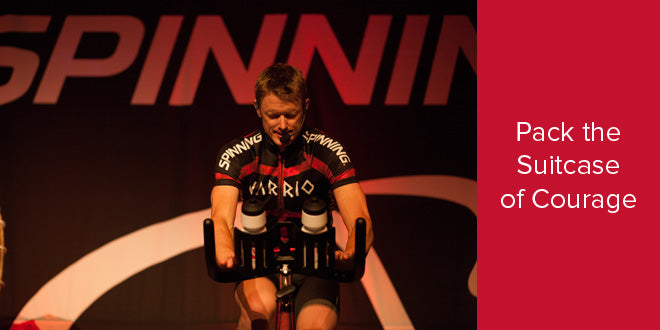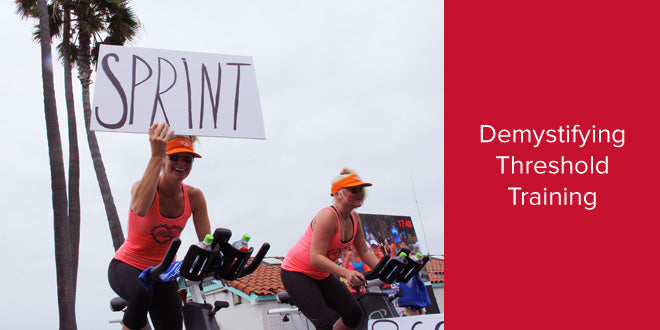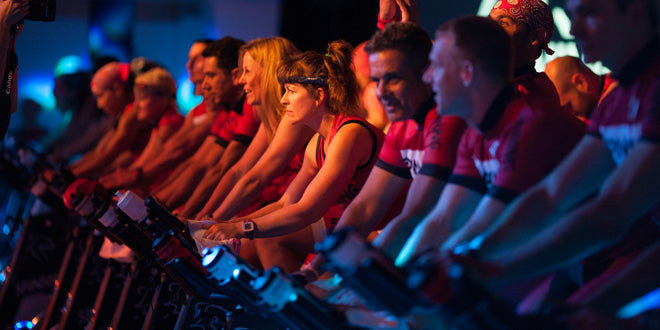By Kate AmosSweat pouring from his brow, a lone rider grimaces as he stares down at the handlebars, each pedal stroke carrying him closer to victory ahead of the chasing pack. In the sport of cycling, riders generally have very little chance of carrying a long solo ride all the way to victory, and yet nearly every race sees brave souls setting off in pursuit of glory. And when they succeed, the results can be spectacular. What does it take to push through the pain and self-doubt to achieve something great? According to legendary cycling commentators Paul Sherwen and Phil Liggett, a rider who gives it their all in spite of long odds is said to be “digging deeply into the suitcase of courage.” Whether you’re driving the peloton in le grande boucle or pushing yourself to complete that last interval in your Spinning® class, this type of mental toughness is a key to success anywhere we face a challenge. Like any other skill, mental toughness is something that can be developed and practiced. When confronting a task that may a first appear daunting, try breaking it up into smaller, achievable targets. Set concrete goals and dates so that you can regularly assess your progress. If your goal is to complete a two-hour Spinning marathon, start with the goal of attending a standard-length class three times a week for three weeks, then add in one 90-minute ride per week. Once you’ve accomplished that you’ll not only be motivated to build on your success, you’ll have established a strong foundation onto which you can add more time and intensity to your riding.Developing strong visualization skills can also help you to pack and maintain your own “suitcase of courage,” and a Spinning training session is the ideal place to do that. Top cyclist Mark Cavendish often talks about how he visualizes himself riding the end of the race so that when the rubber hits the road, he’s already mentally prepared. “The night before, Etixx-Quick-Step's Cavendish will study Google Street View so he knows every corner, street sign and post from 2km out”1. During your warm-up, set aside a few moments to visualize what you want to achieve during that training session. Picture your legs turning in smooth circles as you breathe steadily, hitting a certain power or heart rate target.Another mental toughness strategy – and one of my personal favorites from my road racing days – is positive self-talk. Where the mind goes the body will follow—as the old saying goes, “whether you think you can or you think you can’t, you’re right.” Whenever I would get towards the end of a tough training interval or race, I would tell myself “I can do anything for two minutes.” Of course the effort could be 30 seconds or six hours, but the principle is the same, and it’s a strategy I still use when faced with challenges in my everyday life off the bike.Finally, it’s important to keep in mind the difference between being tough and overdoing it. You know your own body best, and there are absolutely times when it’s appropriate to back off or take it easy. When you feel like you might be approaching your limit, take a few seconds to assess the situation and ask yourself if you might be able to give just a little bit more, or if it would be wise to save the achievement of that goal for another day. The suitcase of courage is not just about pushing it to your max at all times, but also about knowing yourself so that you can truly give your best effort to all that you hope to accomplish.
Like any other skill, mental toughness is something that can be developed and practiced. When confronting a task that may a first appear daunting, try breaking it up into smaller, achievable targets. Set concrete goals and dates so that you can regularly assess your progress. If your goal is to complete a two-hour Spinning marathon, start with the goal of attending a standard-length class three times a week for three weeks, then add in one 90-minute ride per week. Once you’ve accomplished that you’ll not only be motivated to build on your success, you’ll have established a strong foundation onto which you can add more time and intensity to your riding.Developing strong visualization skills can also help you to pack and maintain your own “suitcase of courage,” and a Spinning training session is the ideal place to do that. Top cyclist Mark Cavendish often talks about how he visualizes himself riding the end of the race so that when the rubber hits the road, he’s already mentally prepared. “The night before, Etixx-Quick-Step's Cavendish will study Google Street View so he knows every corner, street sign and post from 2km out”1. During your warm-up, set aside a few moments to visualize what you want to achieve during that training session. Picture your legs turning in smooth circles as you breathe steadily, hitting a certain power or heart rate target.Another mental toughness strategy – and one of my personal favorites from my road racing days – is positive self-talk. Where the mind goes the body will follow—as the old saying goes, “whether you think you can or you think you can’t, you’re right.” Whenever I would get towards the end of a tough training interval or race, I would tell myself “I can do anything for two minutes.” Of course the effort could be 30 seconds or six hours, but the principle is the same, and it’s a strategy I still use when faced with challenges in my everyday life off the bike.Finally, it’s important to keep in mind the difference between being tough and overdoing it. You know your own body best, and there are absolutely times when it’s appropriate to back off or take it easy. When you feel like you might be approaching your limit, take a few seconds to assess the situation and ask yourself if you might be able to give just a little bit more, or if it would be wise to save the achievement of that goal for another day. The suitcase of courage is not just about pushing it to your max at all times, but also about knowing yourself so that you can truly give your best effort to all that you hope to accomplish.
 Like any other skill, mental toughness is something that can be developed and practiced. When confronting a task that may a first appear daunting, try breaking it up into smaller, achievable targets. Set concrete goals and dates so that you can regularly assess your progress. If your goal is to complete a two-hour Spinning marathon, start with the goal of attending a standard-length class three times a week for three weeks, then add in one 90-minute ride per week. Once you’ve accomplished that you’ll not only be motivated to build on your success, you’ll have established a strong foundation onto which you can add more time and intensity to your riding.Developing strong visualization skills can also help you to pack and maintain your own “suitcase of courage,” and a Spinning training session is the ideal place to do that. Top cyclist Mark Cavendish often talks about how he visualizes himself riding the end of the race so that when the rubber hits the road, he’s already mentally prepared. “The night before, Etixx-Quick-Step's Cavendish will study Google Street View so he knows every corner, street sign and post from 2km out”1. During your warm-up, set aside a few moments to visualize what you want to achieve during that training session. Picture your legs turning in smooth circles as you breathe steadily, hitting a certain power or heart rate target.Another mental toughness strategy – and one of my personal favorites from my road racing days – is positive self-talk. Where the mind goes the body will follow—as the old saying goes, “whether you think you can or you think you can’t, you’re right.” Whenever I would get towards the end of a tough training interval or race, I would tell myself “I can do anything for two minutes.” Of course the effort could be 30 seconds or six hours, but the principle is the same, and it’s a strategy I still use when faced with challenges in my everyday life off the bike.Finally, it’s important to keep in mind the difference between being tough and overdoing it. You know your own body best, and there are absolutely times when it’s appropriate to back off or take it easy. When you feel like you might be approaching your limit, take a few seconds to assess the situation and ask yourself if you might be able to give just a little bit more, or if it would be wise to save the achievement of that goal for another day. The suitcase of courage is not just about pushing it to your max at all times, but also about knowing yourself so that you can truly give your best effort to all that you hope to accomplish.
Like any other skill, mental toughness is something that can be developed and practiced. When confronting a task that may a first appear daunting, try breaking it up into smaller, achievable targets. Set concrete goals and dates so that you can regularly assess your progress. If your goal is to complete a two-hour Spinning marathon, start with the goal of attending a standard-length class three times a week for three weeks, then add in one 90-minute ride per week. Once you’ve accomplished that you’ll not only be motivated to build on your success, you’ll have established a strong foundation onto which you can add more time and intensity to your riding.Developing strong visualization skills can also help you to pack and maintain your own “suitcase of courage,” and a Spinning training session is the ideal place to do that. Top cyclist Mark Cavendish often talks about how he visualizes himself riding the end of the race so that when the rubber hits the road, he’s already mentally prepared. “The night before, Etixx-Quick-Step's Cavendish will study Google Street View so he knows every corner, street sign and post from 2km out”1. During your warm-up, set aside a few moments to visualize what you want to achieve during that training session. Picture your legs turning in smooth circles as you breathe steadily, hitting a certain power or heart rate target.Another mental toughness strategy – and one of my personal favorites from my road racing days – is positive self-talk. Where the mind goes the body will follow—as the old saying goes, “whether you think you can or you think you can’t, you’re right.” Whenever I would get towards the end of a tough training interval or race, I would tell myself “I can do anything for two minutes.” Of course the effort could be 30 seconds or six hours, but the principle is the same, and it’s a strategy I still use when faced with challenges in my everyday life off the bike.Finally, it’s important to keep in mind the difference between being tough and overdoing it. You know your own body best, and there are absolutely times when it’s appropriate to back off or take it easy. When you feel like you might be approaching your limit, take a few seconds to assess the situation and ask yourself if you might be able to give just a little bit more, or if it would be wise to save the achievement of that goal for another day. The suitcase of courage is not just about pushing it to your max at all times, but also about knowing yourself so that you can truly give your best effort to all that you hope to accomplish.References
- Fordyce, Tom. “Mark Cavendish on sprinting: 'It's not like playing chess.'” https://owl.english.purdue.edu/owl/resource/747/07/. June 22, 2015.






Leave a comment
This site is protected by hCaptcha and the hCaptcha Privacy Policy and Terms of Service apply.